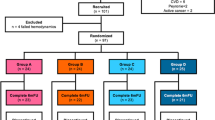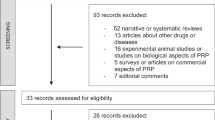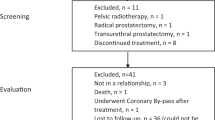Abstract
Low-intensity shockwave therapy (Li-ESWT) has been shown to be an effective and safe treatment for vasculogenic erectile dysfunction (ED). We aim to evaluate the effectiveness and safety of LiESWT in treating patients affected from vasculogenic ED who did not respond to oral treatment with Phosphodiesterase 5 inhibitors (PDE5-i). It is a multicentric open-label prospective study, in a cohort of patients non-responders to PDE-5i. Li-ESWT was performed in an outpatient setting by using the following schedule: 3000 shockwaves with an energy of 0.25 mJ/mm2 and a frequency of 4–6 Hz, twice a week for 3 weeks. International Index of Erectile Function, Erection Hardness Score and Sexual Quality of Life-Male questionnaires, and penile doppler ultrasound (PDU) are the outcome measurements. The Student t-test or Wilcoxon signed-rank test were applied to compare variables, with results considered statistically significant at p < 0.05. 106 (97.2%) completed treatment and performed follow-up visit after 4 weeks. At follow up visit, the mean IIEF-EF increased by 8.6 points (13.47 ± 4.61 vs 22.07 ± 5.27; p < 0.0001). A clinically significant improvement of IIEF-EF was achieved in 75 patients (70.7%). An EHS score ≥ 3, sufficient for a full intercourse, was reported by 72 patients (67.9%) at follow-up visit. 37 (34.9%) patients reported a full rigid penis (EHS = 4) after treatment. Li-ESWT treatment was also able to improve quality of life (SQOL-M: 45.56 ± 8.00 vs 55.31 ± 9.56; p < 0.0001). Li-ESWT significantly increased mean PSV (27.79 ± 5.50 vs 41.66 ± 8.59; p < 0.0001) and decreased mean EDV (5.66 ± 2.03 vs 1.93 ± 2.11; p < 0.0001) in PDU. Combination of Li-ESWT and PDE5-i represents an effective and safe treatment for patients affected from ED who do not respond to first line oral therapy.
This is a preview of subscription content, access via your institution
Access options
Subscribe to this journal
Receive 8 print issues and online access
$259.00 per year
only $32.38 per issue
Buy this article
- Purchase on Springer Link
- Instant access to full article PDF
Prices may be subject to local taxes which are calculated during checkout

Similar content being viewed by others
References
Feldman HA, Goldstein I, Hatzichristou DG, Krane RJ, McKinlay JB. Impotence and its medical and psychosocial correlates: results of the Massachusetts Male Aging Study. J Urol. 1994;151:54.
Dong JY, Zhang YH, Qin LQ. Erectile dysfunction and risk of cardiovascular disease: meta-321 analysis of prospective cohort studies. J Am Coll Cardiol. 2011;58:1378.
Raheem OA, Su JJ, Wilson JR, Hsieh TC. The Association of Erectile Dysfunction and Cardiovascular Disease: a systematic critical review. Am J Mens Health 2017;11:552–63.
Hatzimouratidis K, Giuliano F, Moncada I, Muneer A, Salonia A, Verze P, Guidelines on male sexual dysfunction. Edition presented at the EAU Annual Congress Barcelona. EAU Guidelines Office, Arnhem, The Netherlands, 2019.
Hatzimouratidis K, Hatzichristou DG. A comparative review of the options for treatment of erectile dysfunction: which treatment for which patient? Drugs. 2005;65:1621–50.
Gruenwald I, Shenfeld O, Chen J, Raviv G, Richter S, Cohen A, et al. Positive effect of counseling and dose adjustment in patients with erectile dysfunction who failed treatment with sildenafil. Eur Urol. 2006;50:134–40.
Hatzimouratidis K, Moysidis K, Bekos A, Tsimtsiou Z, Ioannidis E, Hatzichristou D. Treatment strategy for “nonresponders” to tadalafil and vardenafil: a real-life study. Eur Urol. 2006;50:126–32.
Arcaniolo, D, Autorino, R, Balsamo, R, De Sio, M. Optimum use of second line treatment option for erectile dysfunction. Pract Tips Urol. 2016;157–77. https://doi.org/10.1007/978-1-4471-4348-2_17.
Gruenwald I, Appel B, Vardi Y. Low-intensity extracorporeal shock wave therapy—a novel effective treatment for erectile dysfunction in severe ED patients who respond poorly to PDE5 inhibitor therapy. J Sex Med. 2012;9:259–64.
Fode M, Hatzichristodoulou G, Serefoglu EC, Verze P, Albersen M. Low-intensity shockwave therapy for erectile dysfunction: is the evidence strong enough? Nat Rev Urol. 2017;14:593–606.
Olsen AB, Persiani M, Boie S, Hanna M, Lund L. Can low-intensity extracorporeal shockwave therapy improve erectile dysfunction? A prospective, randomized, double-blind, placebo-controlled study. Scand J Urol. 2015;49:329–33.
Sokolakis I, Hatzichristodoulou G. Clinical studies on low intensity extracorporeal shockwave therapy for erectile dysfunction: a systematic review and meta-analysis of randomised controlled trials. Int J Impot Res. 2019;31:177–94.
Sokolakis I, Dimitriadis F, Teo P, Hatzichristodoulou G, Hatzichristou D, Giuliano F. The basic science behind low-intensity extracorporeal shockwave therapy for erectile dysfunction: a systematic scoping review of pre-clinical studies. J Sex Med. 2019;16:168–94.
Fisher AB, Chien S, Barakat AI, Nerem RM. Endothelial cellular response to altered shear stress. Am J Physiol Lung Cell Mol Physiol. 2001;281:L529–33.
Liu T, Shindel AW, Lin G, Lue TF. Cellular signaling pathways modulated by low-intensity 355 extracorporeal shock wave therapy. Int J Impot Res. 2019;31:170–6.
Kitrey ND, Vardi Y, Appel B, Shechter A, Massarwi O, Abu-Ghanem Y, et al. Penile low intensity 357 shock wave treatment is able to shift PDE5i nonresponders to responders: a double-blind, sham controlled study. J Urol. 2016;195:1550.
Bechara A, Casabé A, De Bonis W, Ciciclia PG. Twelve-month efficacy and safety of low intensity shockwave therapy for erectile dysfunction in patients who do not respond to phosphodiesterase type 5 inhibitors. Sex Med. 2016;4:e225.
Tsai CC, Wang CJ, Lee YC, Kuo YT, Lin HH, Li CC, et al. Low-intensity extracorporeal shockwave therapy can improve erectile function in patients who failed to respond to phosphodiesterase type 5 inhibitors. Am J Mens Health. 2017;11:1781–90.
Patel P, Fode M, Lue T, Ramasamy R. Should low-intensity extracorporeal shockwave therapy be the first-line erectile dysfunction treatment for nonresponders to phosphodiesterase type 5 inhibition? Eur Urol Focus. 2019;5:526–8.
Rosen RC, Riley A, Wagner G, Osterloh IH, Kirkpatrick J, Mishra A. The international index of erectile function (IIEF): a multidimensional scale for assessment of erectile dysfunction. Urology. 1997;49:822–30.
Cappelleri JC, Rosen RC, Smith MD, Mishra A, Osterloh IH. Diagnostic evaluation of the erectile function domain of the International Index of Erectile Function. Urology. 1999;54:346–51.
Mulhall JP, Goldstein I, Bushmakin AG, Cappelleri JC, Hvidsten K. Validation of the erection hardness score. J Sex Med. 2007;4:1626–34.
Abraham L, Symonds T, Morris MF. Psychometric validation of a sexual quality of life questionnaire for use in men with premature ejaculation or erectile dysfunction. J Sex Med. 2008;5:595–601.
Sikka SC, Hellstrom WJ, Brock G, Morales AM. Standardization of vascular assessment of erectile dysfunction: standard operating procedures for duplex ultrasound. J Sex Med. 2013;10:120.
Chung E, Cartmill R. Evaluation of clinical efficacy, safety and patient satisfaction rate after low intensity extracorporeal shockwave therapy for the treatment of male erectile dysfunction: an Australian first open-label single-arm prospective clinical trial. BJU Int. 2015;115(Suppl 5):S46–9.
Rosen RC, Allen KR, Ni X, Araujo AB. Minimal clinically important differences in the erectile function domain of the International Index of Erectile Function scale. Eur Urol. 2011;60:1010.
Hatzichristou DG. Sildenafil citrate: lessons learned from 3 years of clinical experience. Int J Impot Res. 2002;14(Suppl 1):S43–52.
Lakin MM, Montague DK, VanderBrug Medendorp S, Tesar L, Schover LR. Intracavernous injection therapy: analysis of results and complications. J Urol. 1990;143:1138–41.
Yuan J, Hoang AN, Romero CA, Lin H, Dai Y, Wang R. Vacuum therapy in erectile dysfunction—science and clinical evidence. Int J Impot Res. 2010;22:211–9.
Vardi Y, Appel B, Jacob G, Massarwi O, Gruenwald I. Can low-intensity extracorporeal shockwave therapy improve erectile function? A 6-month follow-up pilot study in patients with organic erectile dysfunction. Eur Urol. 2010;58:243–8.
Lu Z, Lin G, Reed-Maldonado A, Wang C, Lee YC, Lue TF. Low-intensity extracorporeal shock wave treatment improves erectile function: a systematic review and meta-analysis. Eur Urol. 2017;71:223–33.
Kalyvianakis D, Memmos E, Mykoniatis I, Kapoteli P, Memmos D, Hatzichristou D. Low-intensity shockwave therapy for erectile dysfunction: a randomized clinical trial comparing 2 treatment protocols and the impact of repeating treatment. J Sex Med. 2018;15:334–45.
Fojecki GL, Tiessen S, Osther PJS. Effect of linear low-intensity extracorporeal shockwave therapy for erectile dysfunction-12-month follow-up of a randomized, double-blinded, sham-controlled study. Sex Med. 2018;6:1–7.
Kalyvianakis D, Hatzichristou D. Low-intensity shockwave therapy improves hemodynamic parameters in patients with vasculogenic erectile dysfunction: a triplex ultrasonography-based sham-controlled trial. J Sex Med. 2017;14:891–7.
La Vignera S, Calogero AE, Cannizzaro MA, Condorelli R, Noto Z, Vicari E. Tadalafil and modifications in peak systolic velocity (Doppler spectrum dynamic analysis) in the cavernosal arteries of patients with type 2 diabetes after continuous tadalafil treatment. Minerva Endocrinol. 2006;31:251–61.
Xuan XJ, Bai G, Zhang CX, Xu C, Lu FD, Peng Y, et al. The application of color Doppler flow imaging in the diagnosis and therapeutic effect evaluation of erectile dysfunction. Asian J Androl. 2016;18:118–22.
Kitrey ND, Vardi Y, Appel B, Shechter A, Massarwi O, Abu-Ghanem Y, et al. Low intensity shock wave treatment for erectile dysfunction-how long does the effect last? J Urol. 2018;200:167–70.
Author information
Authors and Affiliations
Consortia
Corresponding author
Ethics declarations
Conflict of interest
The authors declare that they have no conflict of interest.
Additional information
Publisher’s note Springer Nature remains neutral with regard to jurisdictional claims in published maps and institutional affiliations.
A list of SIA-Low intensity shock wave for Erectile Dysfunction (LED) Study Group members and their affiliations appears at the end of the paper.
Rights and permissions
About this article
Cite this article
Palmieri, A., Arcaniolo, D., Palumbo, F. et al. Low intensity shockwave therapy in combination with phosphodiesterase-5 inhibitors is an effective and safe treatment option in patients with vasculogenic ED who are PDE5i non-responders: a multicenter single-arm clinical trial. Int J Impot Res 33, 634–640 (2021). https://doi.org/10.1038/s41443-020-0332-7
Received:
Revised:
Accepted:
Published:
Issue Date:
DOI: https://doi.org/10.1038/s41443-020-0332-7
This article is cited by
-
Long-term effects of combination treatment comprising low-intensity extracorporeal shockwave therapy and tadalafil for patients with erectile dysfunction: a retrospective study
International Journal of Impotence Research (2023)
-
Conservative Non-surgical Options for Erectile Dysfunction
Current Urology Reports (2023)
-
Low-intensity extracorporeal shock wave therapy (Li-ESWT) for priapism-induced erectile dysfunction in young patients: the first case series
International Journal of Impotence Research (2022)
-
Low-intensity extracorporeal shock wave therapy among urologist practitioners: how the opinion of urologists changed between 2016 and 2019
International Journal of Impotence Research (2022)



